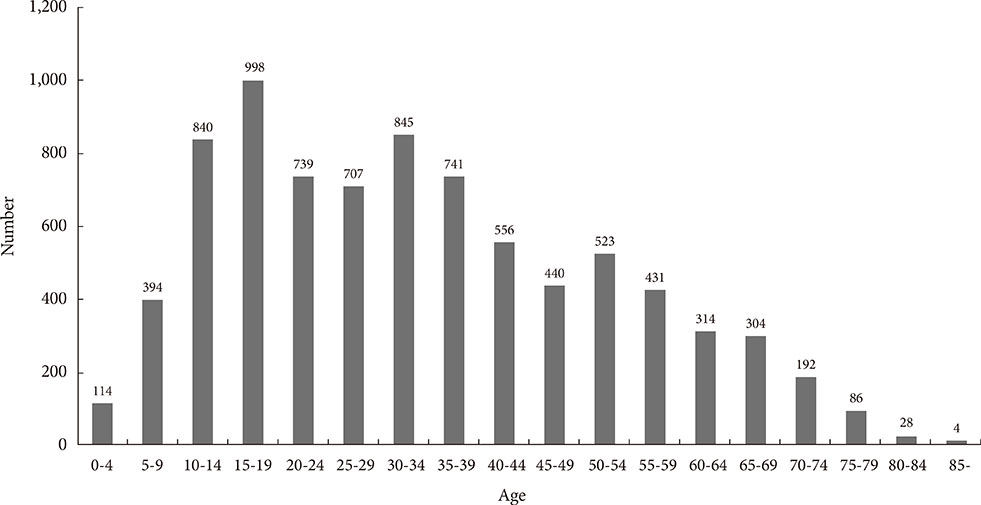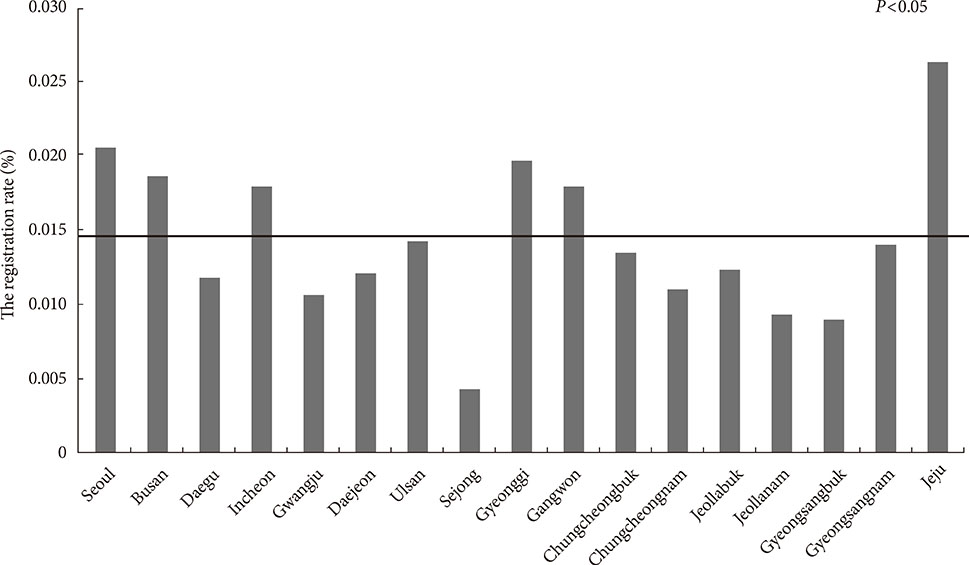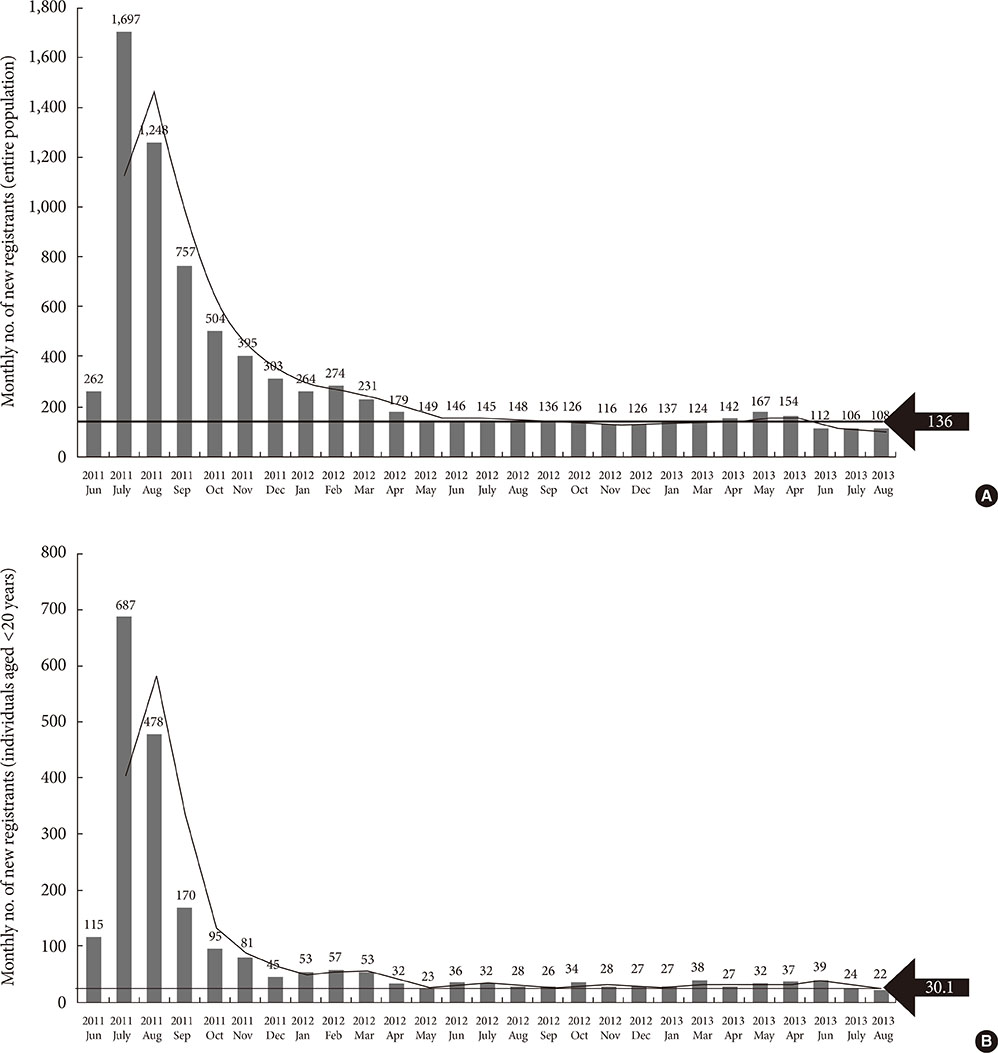Epidemiology of Type 1 Diabetes Mellitus in Korea through an Investigation of the National Registration Project of Type 1 Diabetes for the Reimbursement of Glucometer Strips with Additional Analyses Using Claims Data
- Affiliations
-
- 1Department of Endocrinology and Metabolism, National Health Insurance Service Ilsan Hospital, Goyang, Korea. ydsyko@gmail.com
- 2National Health Insurance Service, Seoul, Korea.
- KMID: 2383313
- DOI: http://doi.org/10.4093/dmj.2016.40.1.35
Abstract
- BACKGROUND
The aim of this study was to estimate the prevalence and incidence of type 1 diabetes mellitus (T1DM) in Korea. In addition, we planned to do a performance analysis of the Registration Project of Type 1 diabetes for the reimbursement of consumable materials.
METHODS
To obtain nationwide data on the incidence and prevalence of T1DM, we extracted claims data from July 2011 to August 2013 from the Registration Project of Type 1 diabetes on the reimbursement of consumable materials in the National Health Insurance (NHI) Database. For a more detailed analysis of the T1DM population in Korea, stratification by gender, age, and area was performed, and prevalence and incidence were calculated.
RESULTS
Of the 8,256 subjects enrolled over the 26 months, the male to female ratio was 1 to 1.12, the median age was 37.1 years, and an average of 136 new T1DM patients were registered to the T1DM registry each month, resulting in 1,632 newly diagnosed T1DM patients each year. We found that the incidence rate of new T1DM cases was 3.28 per 100,000 people. The average proportion of T1DM patients compared with each region's population was 0.0125%. The total number of insurance subscribers under the universal compulsory NHI in Korea was 49,662,097, and the total number of diabetes patients, excluding duplication, was 3,762,332.
CONCLUSION
The prevalence of T1DM over the course of the study was approximately 0.017% to 0.021% of the entire population of Korea, and the annual incidence of T1DM was 3.28:100,000 overall and 3.25:100,000 for Koreans under 20 years old.
Keyword
MeSH Terms
Figure
Cited by 8 articles
-
Does Diabetes Increase the Risk of Contracting COVID-19? A Population-Based Study in Korea
Sung-Youn Chun, Dong Wook Kim, Sang Ah Lee, Su Jung Lee, Jung Hyun Chang, Yoon Jung Choi, Seong Woo Kim, Sun Ok Song
Diabetes Metab J. 2020;44(6):897-907. doi: 10.4093/dmj.2020.0199.Trends of Diabetes and Prediabetes Prevalence among Korean Adolescents From 2007 to 2018
Ji Hyun Kim, Jung Sub Lim
J Korean Med Sci. 2021;36(17):e112. doi: 10.3346/jkms.2021.36.e112.Development and Validation of the Korean Diabetes Risk Score: A 10-Year National Cohort Study
Kyoung Hwa Ha, Yong-ho Lee, Sun Ok Song, Jae-woo Lee, Dong Wook Kim, Kyung-hee Cho, Dae Jung Kim
Diabetes Metab J. 2018;42(5):402-414. doi: 10.4093/dmj.2018.0014.High Proportion of Adult Cases and Prevalence of Metabolic Syndrome in Type 1 Diabetes Mellitus Population in Korea: A Nationwide Study
You-Bin Lee, Kyungdo Han, Bongsung Kim, Sang-Man Jin, Seung-Eun Lee, Ji Eun Jun, Jiyeon Ahn, Gyuri Kim, Jae Hyeon Kim
Diabetes Metab J. 2019;43(1):76-89. doi: 10.4093/dmj.2018.0048.Diabetes and the Risk of Infection: A National Cohort Study
Eun Jin Kim, Kyoung Hwa Ha, Dae Jung Kim, Young Hwa Choi
Diabetes Metab J. 2019;43(6):804-814. doi: 10.4093/dmj.2019.0071.Trends in Hyperglycemic Crisis Hospitalizations and in- and out-of-Hospital Mortality in the Last Decade Based on Korean National Health Insurance Claims Data
Ji Hong You, Sun Ok Song, Se Hee Park, Kyoung Hye Park, Joo Young Nam, Dong Wook Kim, Hyun Min Kim, Dong-Jun Kim, Yong-ho Lee, Byung-Wan Lee
Endocrinol Metab. 2019;34(3):275-281. doi: 10.3803/EnM.2019.34.3.275.Clinical Outcomes of COVID-19 Patients with Type 2 Diabetes: A Population-Based Study in Korea
Ji Hong You, Sang Ah Lee, Sung-Youn Chun, Sun Ok Song, Byung-Wan Lee, Dae Jung Kim, Edward J. Boyko
Endocrinol Metab. 2020;35(4):901-908. doi: 10.3803/EnM.2020.787.Exercise Frequency Reduction Is Associated With Higher Risk of Infection in Newly Diagnosed Diabetes: A Nationally Representative Cohort Study
Yohwan Lim, Hye Jun Kim, Sung Soo Yoon, Sang Jun Lee, Myeong Hoon Lee, Hyewon Park, Sun Jae Park, Seogsong Jeong, Hyun Wook Han
J Korean Med Sci. 2023;38(23):e176. doi: 10.3346/jkms.2023.38.e176.
Reference
-
1. DIAMOND Project Group. Incidence and trends of childhood type 1 diabetes worldwide 1990-1999. Diabet Med. 2006; 23:857–866.2. EURODIAB ACE Study Group. Variation and trends in incidence of childhood diabetes in Europe. Lancet. 2000; 355:873–876.3. Green A, Gale EA, Patterson CC. Incidence of childhood-onset insulin-dependent diabetes mellitus: the EURODIAB ACE Study. Lancet. 1992; 339:905–909.4. SEARCH for Diabetes in Youth Study Group. Liese AD, D'Agostino RB Jr, Hamman RF, Kilgo PD, Lawrence JM, Liu LL, Loots B, Linder B, Marcovina S, Rodriguez B, Standiford D, Williams DE. The burden of diabetes mellitus among US youth: prevalence estimates from the SEARCH for Diabetes in Youth Study. Pediatrics. 2006; 118:1510–1518.5. Reichard P, Nilsson BY, Rosenqvist U. The effect of long-term intensified insulin treatment on the development of microvascular complications of diabetes mellitus. N Engl J Med. 1993; 329:304–309.6. Patterson CC, Dahlquist GG, Gyurus E, Green A, Soltesz G. EURODIAB Study Group. Incidence trends for childhood type 1 diabetes in Europe during 1989-2003 and predicted new cases 2005-20: a multicentre prospective registration study. Lancet. 2009; 373:2027–2033.7. Mayer-Davis EJ, Bell RA, Dabelea D, D'Agostino R Jr, Imperatore G, Lawrence JM, Liu L, Marcovina S. SEARCH for Diabetes in Youth Study Group. The many faces of diabetes in American youth: type 1 and type 2 diabetes in five race and ethnic populations: the SEARCH for Diabetes in Youth Study. Diabetes Care. 2009; 32:Suppl 2. S99–S101.8. Centers for Disease Control and Prevention. National diabetes fact sheet: national estimates and general information on diabetes and prediabetes in the United States, 2011. Atlanta: U.S. Department of Health and Human Services, Centers for Disease Control and Prevention;2011. p. 201.9. International Diabetes Federation: IDF Diabetes Atlas 6th edition. cited 2015 Oct 14. Available from: http://www.idf.org/diabetesatlas.10. Ko KW, Yang SW, Cho NH. The incidence of IDDM in Seoul from 1985 to 1988. Diabetes Care. 1994; 17:1473–1475.11. Shin CH. Epidemiologic characteristics of type 1 diabetes in children aged 14 years or under in Korea, 1985-2000. Korean J Pediatr. 2008; 51:569–575.12. Song SO, Jung CH, Song YD, Park CY, Kwon HS, Cha BS, Park JY, Lee KU, Ko KS, Lee BW. Background and data configuration process of a nationwide population-based study using the Korean National Health Insurance system. Diabetes Metab J. 2014; 38:395–403.13. Karvonen M, Viik-Kajander M, Moltchanova E, Libman I, LaPorte R, Tuomilehto J. Diabetes Mondiale (DiaMond) Project Group. Incidence of childhood type 1 diabetes worldwide. Diabetes Care. 2000; 23:1516–1526.14. Levy-Marchal C, Patterson CC, Green A. EURODIAB ACE Study Group Europe and Diabetes. Geographical variation of presentation at diagnosis of type I diabetes in children: the EURODIAB study. European and Dibetes. Diabetologia. 2001; 44:Suppl 3. B75–B80.15. Lee HK, Oh YS, Chung YH, Yoo HJ, Shin SH, Son HY, Kim SW, Lee HC, Huh KB, Choi YK. Epidemiological characteristics of ketoacidosis among Korean diabetic patients. J Korean Med Sci. 1987; 2:7–11.16. Rhee BD. Epidemiological characteristics of diabetes mellitus among Korean population. J Korean Diabetes Assoc. 2003; 27:173–178.17. Shin CH. Type 1 diabetes mellitus. J Korean Pediatr Soc. 2002; 45:1181–1191.18. Levy-Marchal C, Patterson C, Green A. The EURODIAB ACE Study Group. Variation by age group and seasonality at diagnosis of childhood IDDM in Europe. Diabetologia. 1995; 38:823–830.19. Gale EA. Latent autoimmune diabetes in adults: a guide for the perplexed. Diabetologia. 2005; 48:2195–2199.20. Rawshani A, Landin-Olsson M, Svensson AM, Nystrom L, Arnqvist HJ, Bolinder J, Gudbjornsdottir S. The incidence of diabetes among 0-34 year olds in Sweden: new data and better methods. Diabetologia. 2014; 57:1375–1381.21. Liu LL, Yi JP, Beyer J, Mayer-Davis EJ, Dolan LM, Dabelea DM, Lawrence JM, Rodriguez BL, Marcovina SM, Waitzfelder BE, Fujimoto WY. SEARCH for Diabetes in Youth Study Group. Type 1 and type 2 diabetes in Asian and Pacific Islander U.S. youth: the SEARCH for Diabetes in Youth Study. Diabetes Care. 2009; 32:Suppl 2. S133–S140.22. Kim DJ. The epidemiology of diabetes in Korea. Diabetes Metab J. 2011; 35:303–308.




